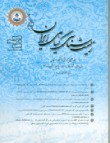Study of some physiological and biochemical parameters of Okra plant (Abelmoschus esculentus L.) under salt stress in the presence of chitosan nanoparticles
Author(s):
Article Type:
Research/Original Article (دارای رتبه معتبر)
Abstract:
In this study, the effects of chitosan nanoparticles at two levels of 0.2 and 0.4 g/L under salinity stress conditions (at two levels of 75 and 150 mM) on biochemical and physiological indicators of Okra (Abelmoschus esculentus L.) were studied. The experiment was conducted as a two-factor factorial based on a completely randomized design in four replications. The results of variance analysis of the data showed that the effect of chitosan nanoparticles on fresh weight, dry weight, length, malondialdehyde, soluble sugar, starch, total phenol content, and DPPH inhibition percentage in aerial and root parts, chlorophylls, carotenoid, flavonoid, and anthocyanin content in the aerial part was significant at p<1%. Comparison of average data showed that at 150 mM salinity in the aerial and root parts, fresh weight 1.46 and 1.31, dry weight 1.5 and 1.4, and length 1.27 and 1.52 times showed the most significant decrease compared to the control. Also, chlorophyll a 1.8, b 1.2, and carotenoid 1.6 times in the aerial part, starch 1.8 and 3.6, IC50 inhibition percentage 1.61 and 4.4 times in the aerial and root parts showed the most significant decrease in salinity of 150 mM compared to the control. Treatment with nanoparticles of 0.2 and 0.4 g/L increased chlorophyll a (1.38 and 1.39), b (1.19 and 1.18), carotenoid (1.3 and 4.1) in leaves, and flavonoid (1.7 and 1.5) and anthocyanin (1.3 and 1.5) times in aerial part and increase of soluble sugar (1.6 and 1.8; 1.6 and 1.5), total phenol (1.11 and 1.16; 1.19 and 1.3) times, respectively in shoots and roots and reduction of malondialdehyde (1.6, 1.8, 1.7, 2.8), and starch concentration (1.38, 1.43, 1.9 and 2.4) and IC50 inhibition percentage (1.13, 1.32, 1.14 and 1.75) times were in aerial and root parts. Chitosan nanoparticles at two levels of 0.2 and 0.4 g per liter improved the negative effects of salinity, and in general, chitosan nanoparticles at a concentration of 0.4 g/L showed better performance in improving both levels of salinity.IntroductionOne of the main problems in arid and semi-arid areas is soil salinity, which reduces the growth and productivity of crops (Sheikhalipour et al., 2021). Chitosan is a defense stimulant, but its use is extremely limited due to the lack of solubility in water environments. Nanoparticles have many applications in agriculture and industry due to their properties of high permeability, solubility, biodegradability, non-toxicity, and affordability. Chitosan nanoparticles are unique due to their high ratio of surface-to-volume, size-dependent quality, and optical properties (Sathiyabama and Manikandan, 2016). In maize (Zea mays) (Oliveira et al., 2016) and thistle (Silybum marianum) (Mosavikia et al., 2020), the use of chitosan nanoparticles in increasing salinity tolerance has also been studied. The Okra plant belongs to the Malvaceae family and will experience a yield decrease of up to 50% with an increase in soil salinity (Salehi Salmi and Daneshvar, 2016). Due to the increasing population and the daily food needs of the people, the use of plant growth regulators and nanotechnology for cultivation in maximum areas will be efficient strategies for improving plant resistance to adverse environmental conditions, especially the salinity of soils during the plant growth period.In the present study, an attempt has been made to investigate the biochemical and physiological indicators of the Okra plant under salt stress and the effect of chitosan nanoparticles on mitigating the negative effects of salinity stress. Materials and Methods In this research, green Okra seeds of the Clemson Spineless variety with registration number: GB-34265 were prepared by Pakan Seed Company of Isfahan. The treatment was done with 0.2 and 0.4 grams per liter of chitosan nanoparticles as foliar spraying. Salt stress was applied at the levels of 75 and 150 mM along with Hoagland's solution. Different growth and biochemical parameters were measured after taking the samples of the control and treatment groups. The parameters were the length of the aerial part and the root, the dry weight (after 72 hours of drying in the oven), chlorophyll and carotenoid content (Lichtenthaler, 1987), the amount of total flavonoid (Chang et al., 2002), total phenol (Marinova et al., 2005), anthocyanin (Fulcki and Francis, 1968), the percentage of radical collection (2, 2-diphenyl 1-picrylhydrazyl DPPH) (Burits and Bucar, 2000), the amount of soluble sugars (by the phenol sulfuric acid method), starch (Magne et al., 2006), and malondialdehyde (Heath and Packer, 1968). To minimize the experimental errors, sampling was done for each treatment in 4 replicates and three plants in each replicate. The experiment was conducted as a two-factor factorial based on a completely randomized design in four replications. SAS 9.4 software was used for statistical data analysis. Results and discussionComparison of means showed that urban and industrial wastewater treatments caused The results of variance analysis of the data showed that the effect of Chitosan nanoparticles on wet and dry weight, length, the content of Malondialdehyde, Soluble sugar, Starch, total Phenol, and percentage of DPPH inhibition in aerial and root parts, Chlorophylls, Carotenoid, Flavonoid, and Anthocyanin in the aerial part was significant at the probability level of 1%. The comparison of the average data showed that in the salinity of 150 mM in the aerial and root parts, fresh weight was 1.46 and 1.31, dry weight was 1.5 and 1.4, and length was 1.27 and 1.52 times, respectively. Also, Chlorophyll a (1.8), b (1.2), and Carotenoid 1.6 times in the aerial part, Starch 1.8 and 3.6 times, and IC50 inhibition percentage 1.61 and 4.4 times in the aerial part and roots in salinity 150 mM showed the largest decrease compared to the control. Treatment with nanoparticles 0.2 and 0.4 g/liter increased Chlorophyll a (1.38 and 1.39), b (1.19 and 18), and Carotenoid 1.3 and 1.4 times in leaves, and Flavonoid 1.7 and 1.5 and Anthocyanin 3 times 1.1 and 5.1 times in the aerial part, and it also increases the dissolved Sugar 1.6, 1.8, 1.6 and 1.5, total Phenol 1.11 and 1.16, 1.19 and 1.3 times in the aerial parts and roots, respectively. And reducing the content of Malondialdehyde 1.6, 1.8, 1.7, 2.8, Starch 1.43, 1.38, 1.4, 2.9 and IC50 inhibition percentage (1.32, 1.13, 1.14, 1.75) was equal in the aerial and root parts. ConclusionFoliar spraying or soil application of particles with a diameter of less than 100 nanometers has created a promising perspective in the agricultural sector and environmental stress management. Foliar spraying of chitosan nanoparticles on the Okra plant can play a vital role in inhibiting oxidative stress caused by salt. In the present study, chitosan nanoparticles increased the content of chlorophyll a, b, carotenoids, anthocyanins, phenol, and flavonoid and decreased the amount of malondialdehyde, which maintained membrane function and increased tolerance against salt stress. Chitosan nanoparticles at two levels of 0.2 and 0.4 g per liter improved the adverse effects of salinity. Overall, chitosan nanoparticles at a concentration of 0.4 g per liter showed a better performance in improving plant tolerance under both levels of salinity. Chitosan nanoparticles can be introduced as a suitable candidate for mitigating the adverse effects of salinity stress on plants, which can be attributed to the presence of its amine and hydroxyl groups, which are easily accessible in chemical reactions, leading to the improvement of the salt stress and an increase in the productivity of crops.
Keywords:
Language:
Persian
Published:
Iranian Journal of Plant Biology, Volume:14 Issue: 1, 2023
Pages:
17 to 38
magiran.com/p2584026
دانلود و مطالعه متن این مقاله با یکی از روشهای زیر امکان پذیر است:
اشتراک شخصی
با عضویت و پرداخت آنلاین حق اشتراک یکساله به مبلغ 1,390,000ريال میتوانید 70 عنوان مطلب دانلود کنید!
اشتراک سازمانی
به کتابخانه دانشگاه یا محل کار خود پیشنهاد کنید تا اشتراک سازمانی این پایگاه را برای دسترسی نامحدود همه کاربران به متن مطالب تهیه نمایند!
توجه!
- حق عضویت دریافتی صرف حمایت از نشریات عضو و نگهداری، تکمیل و توسعه مگیران میشود.
- پرداخت حق اشتراک و دانلود مقالات اجازه بازنشر آن در سایر رسانههای چاپی و دیجیتال را به کاربر نمیدهد.
In order to view content subscription is required
Personal subscription
Subscribe magiran.com for 70 € euros via PayPal and download 70 articles during a year.
Organization subscription
Please contact us to subscribe your university or library for unlimited access!



